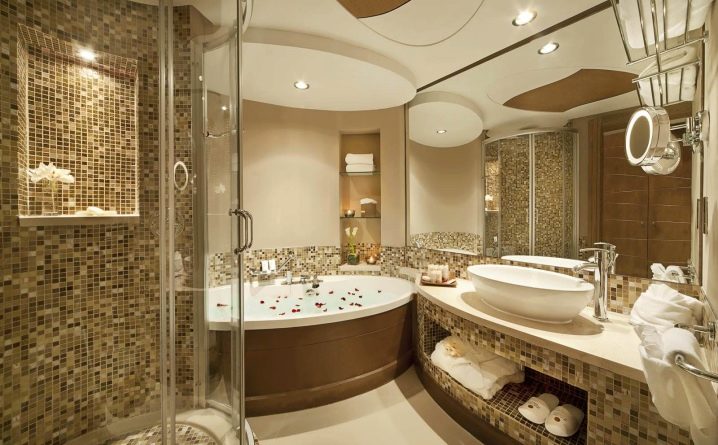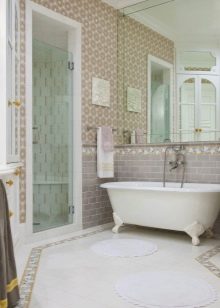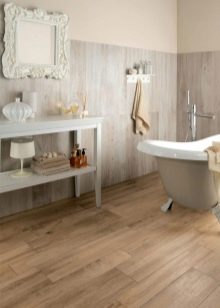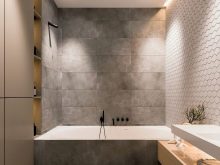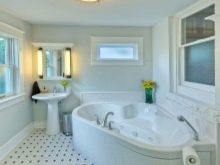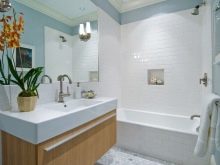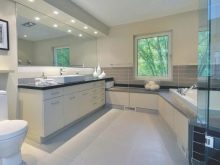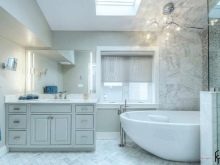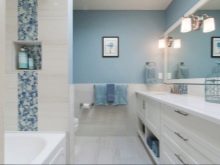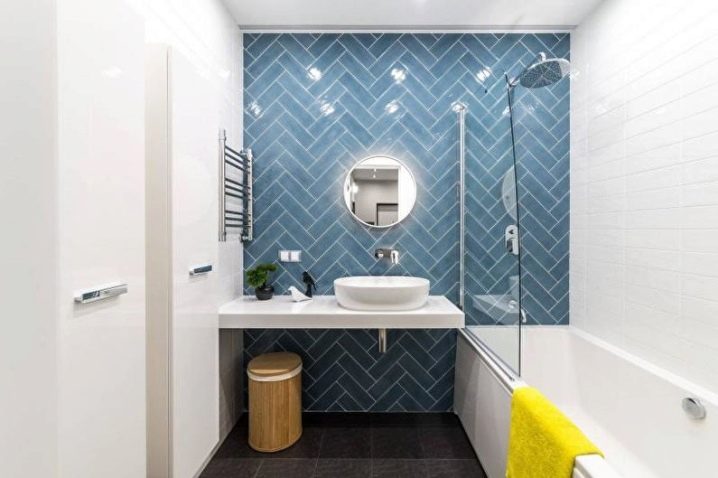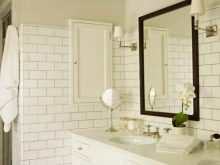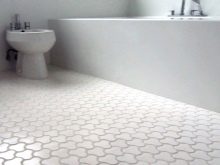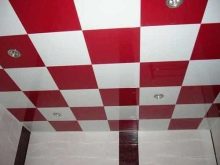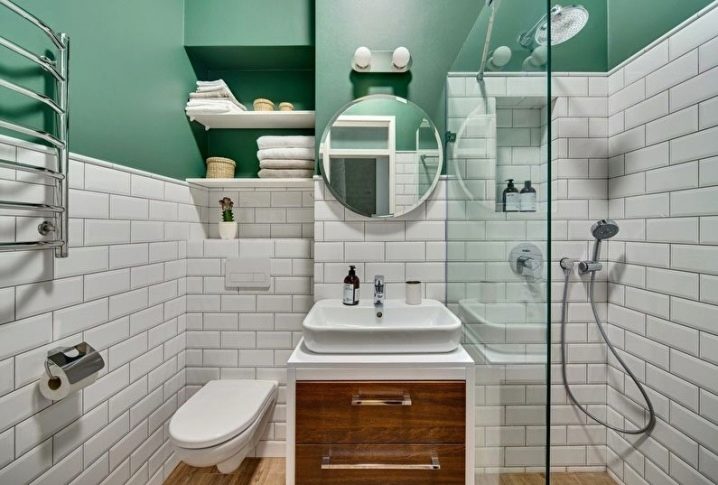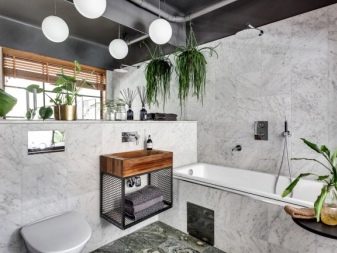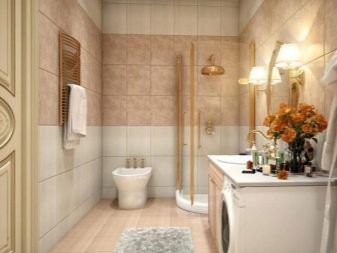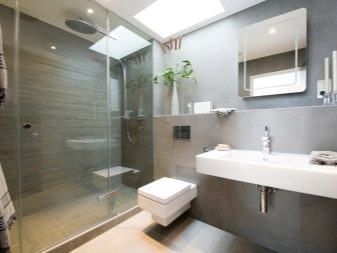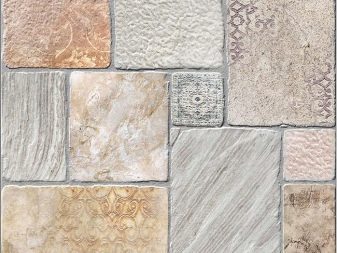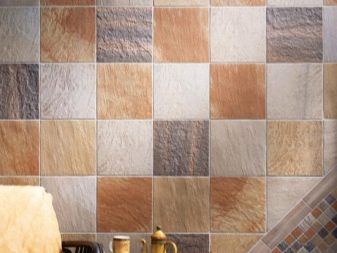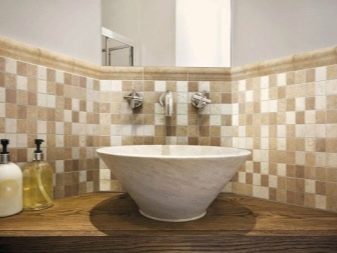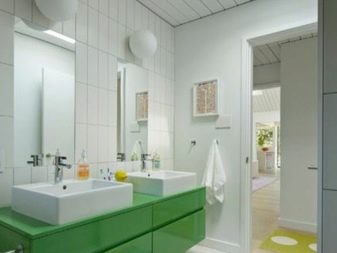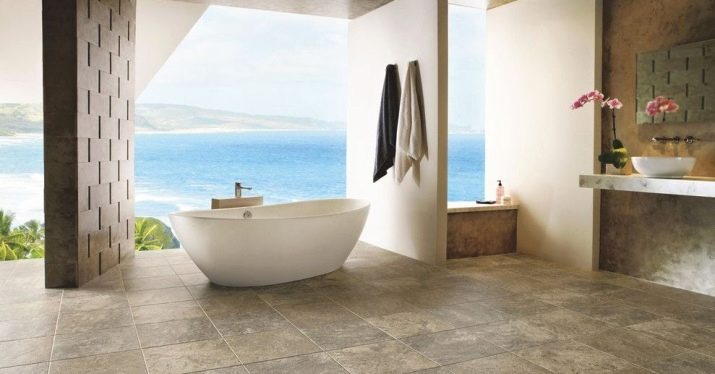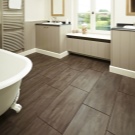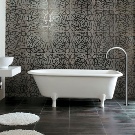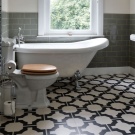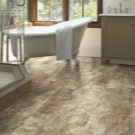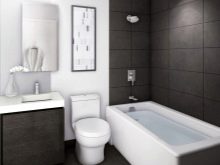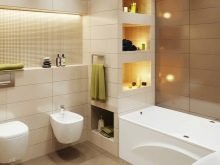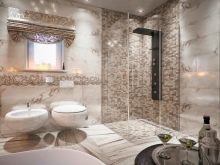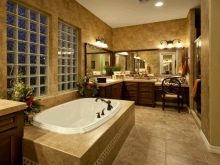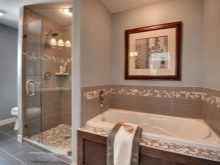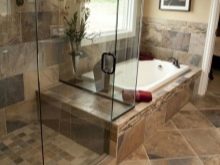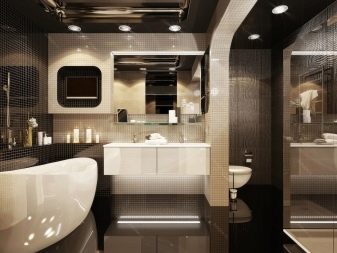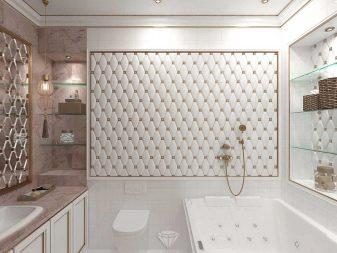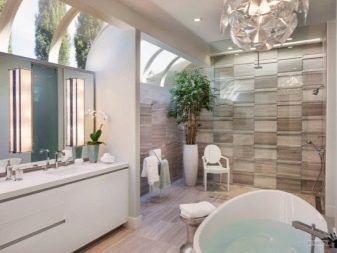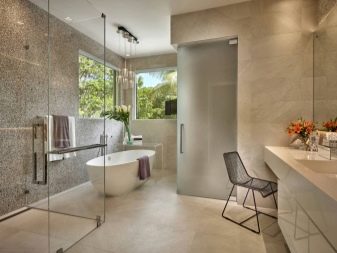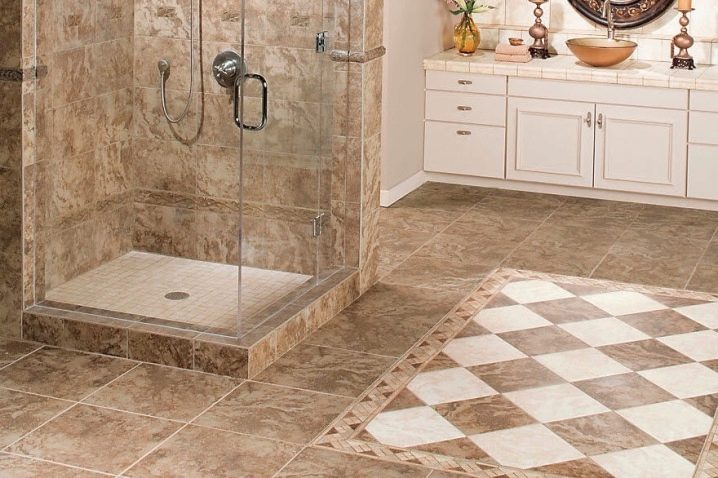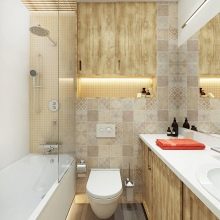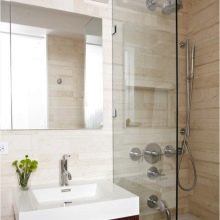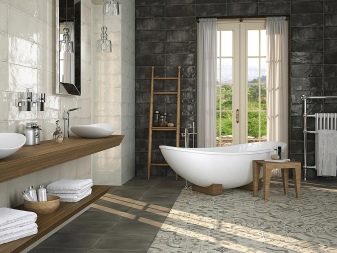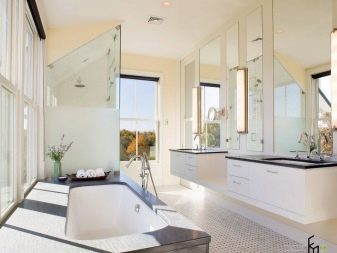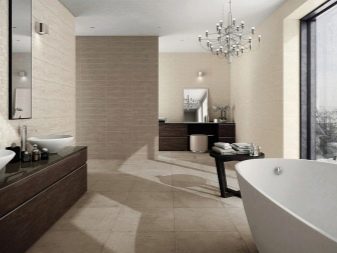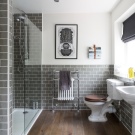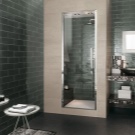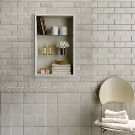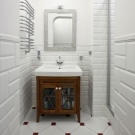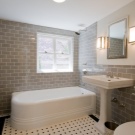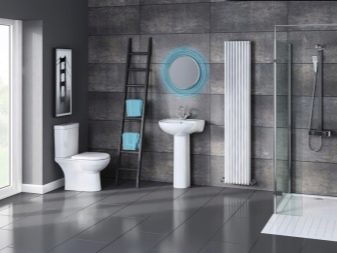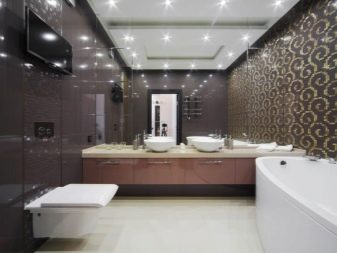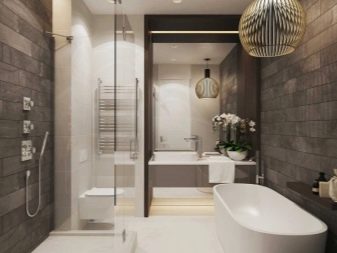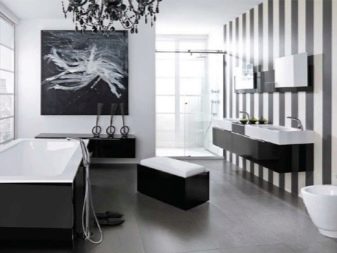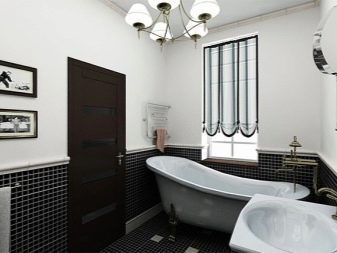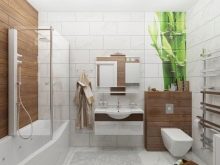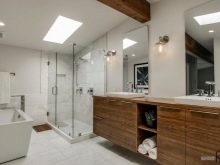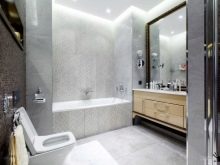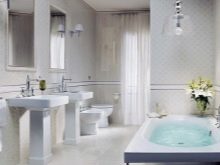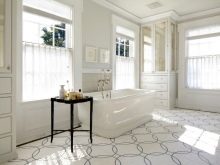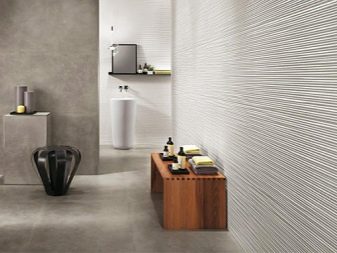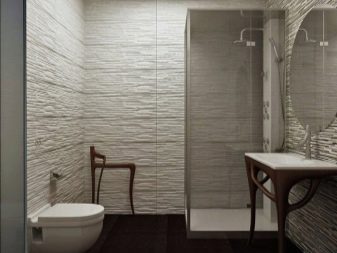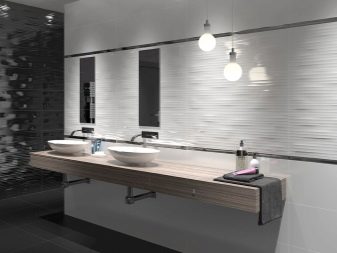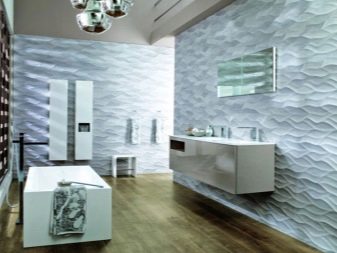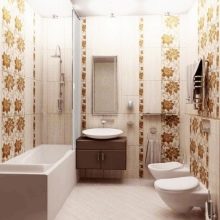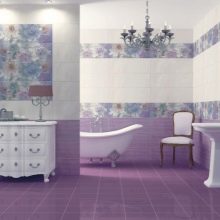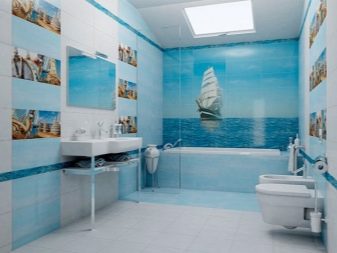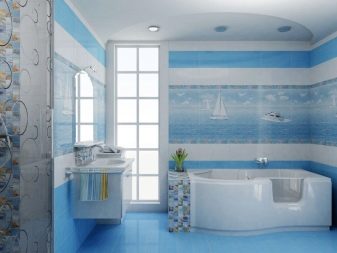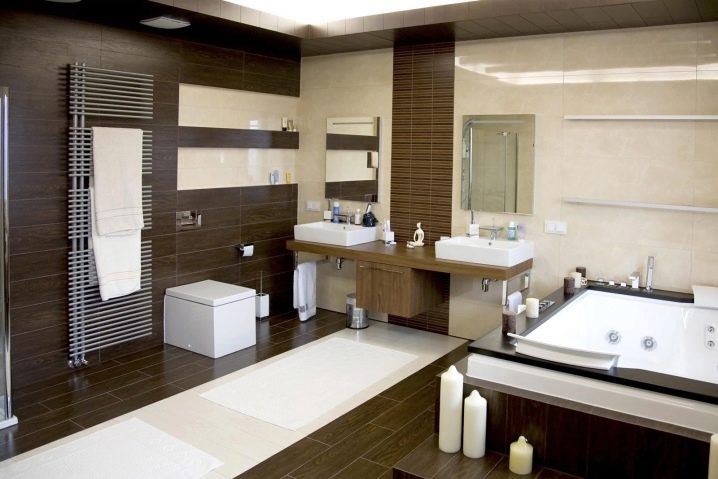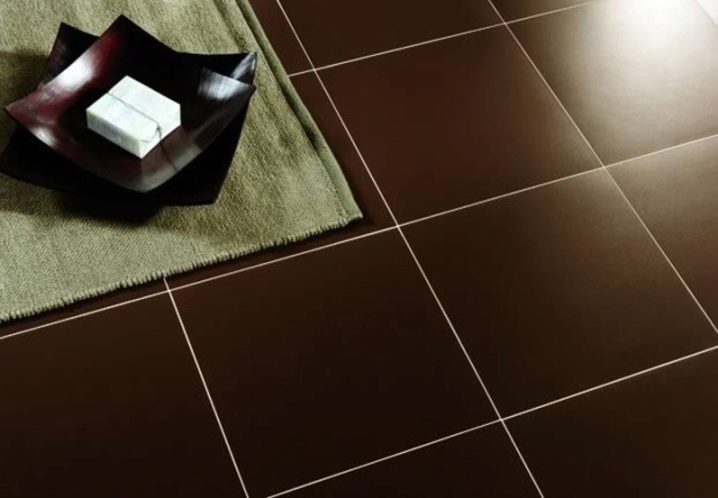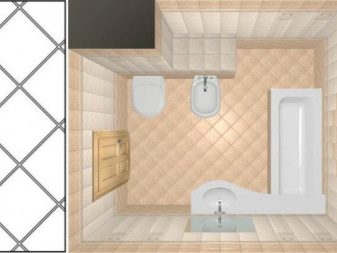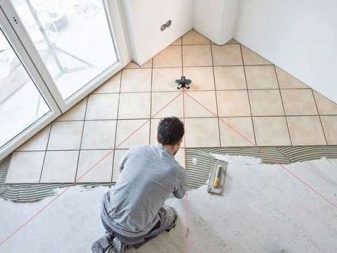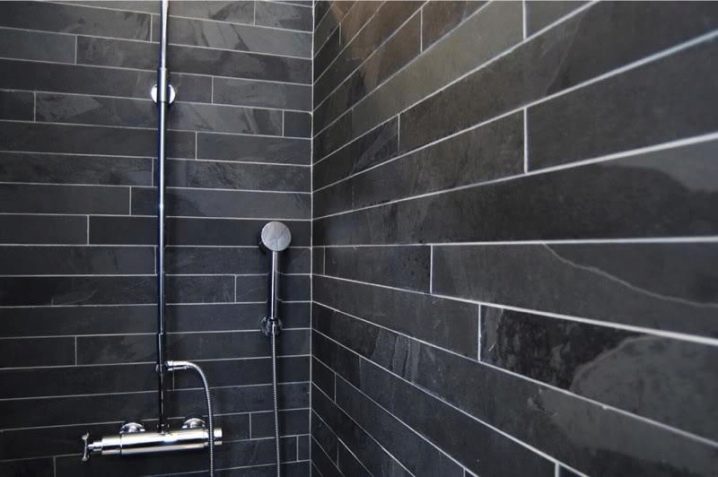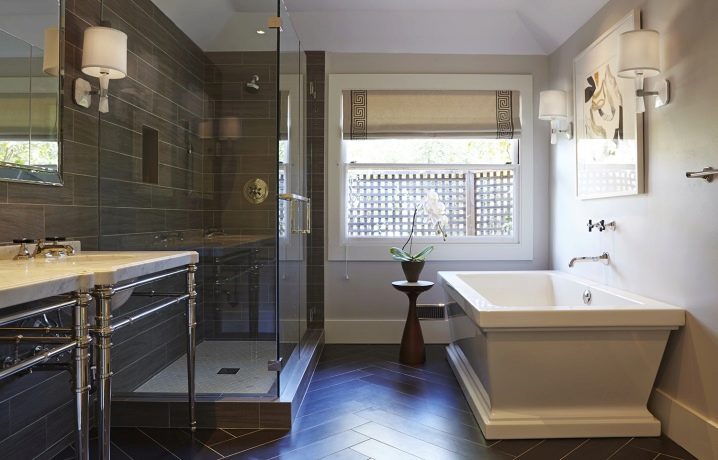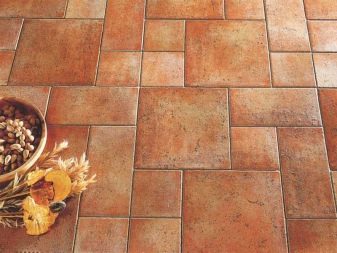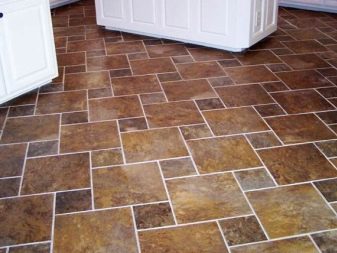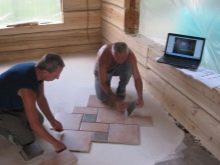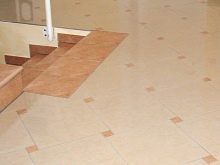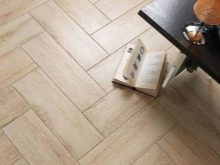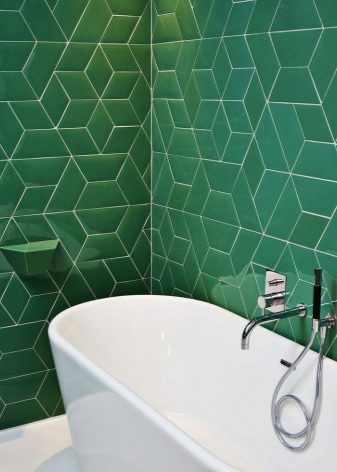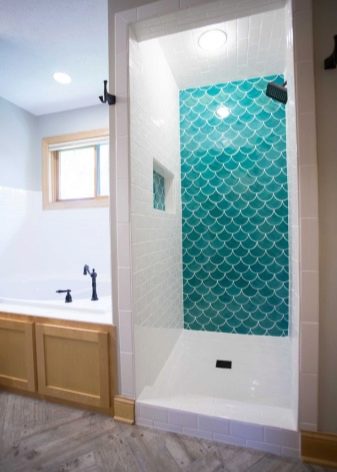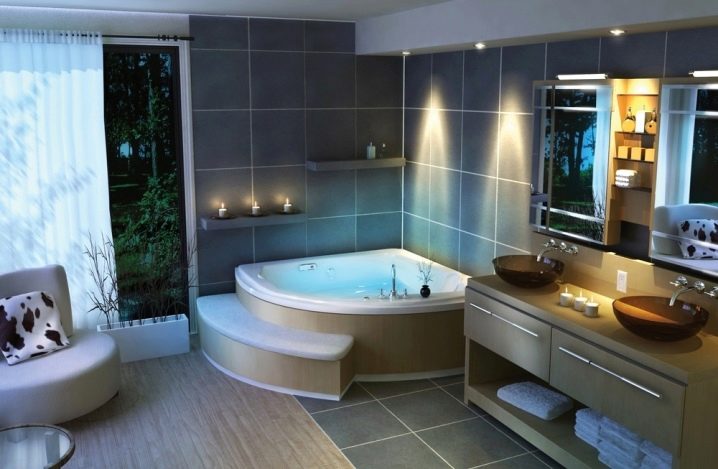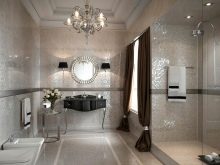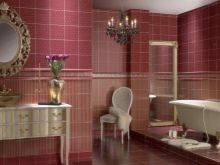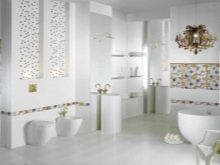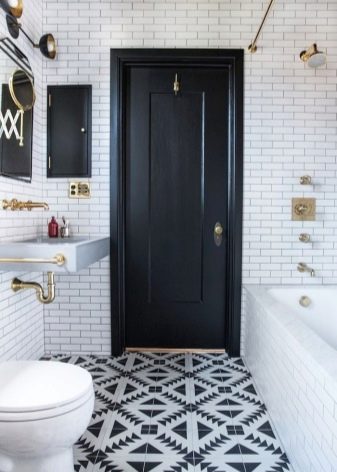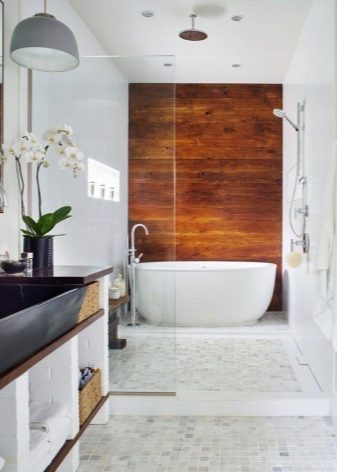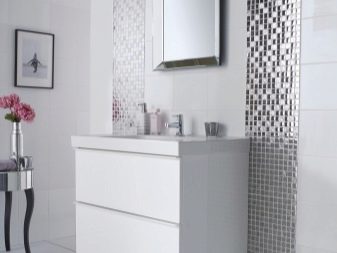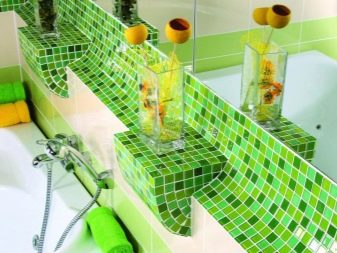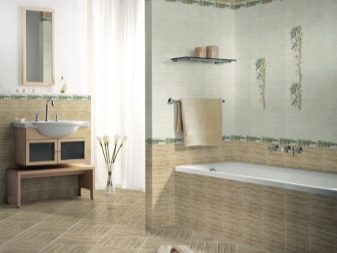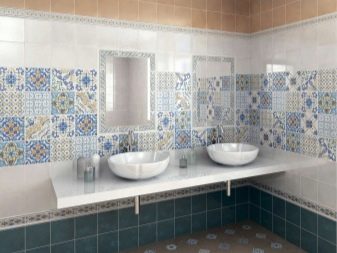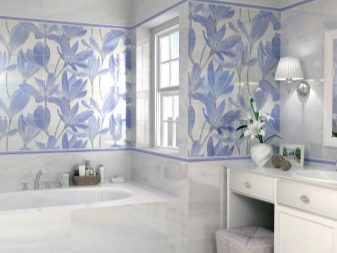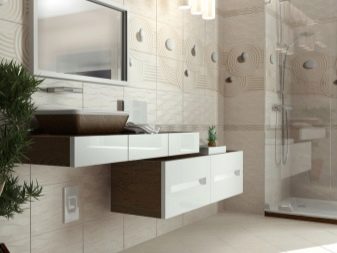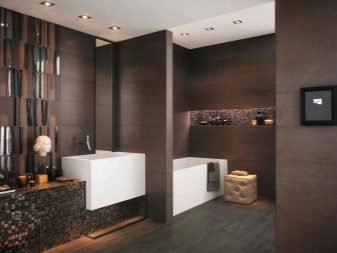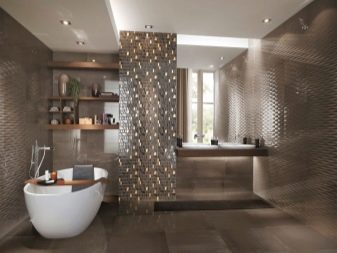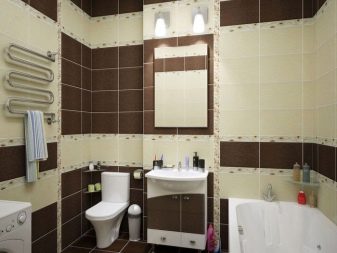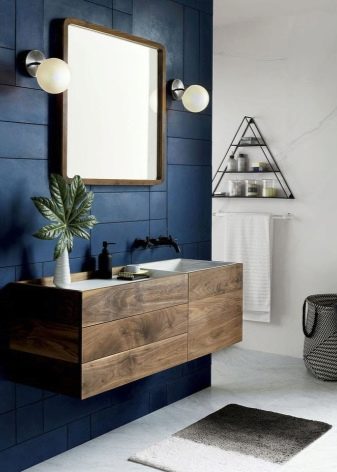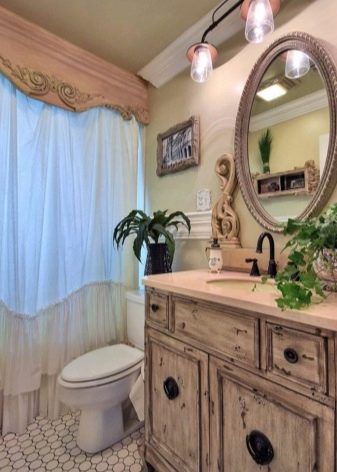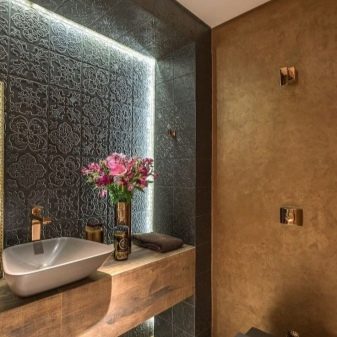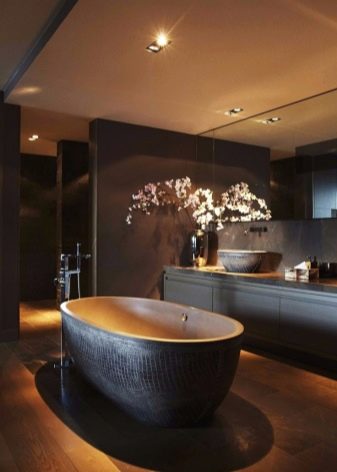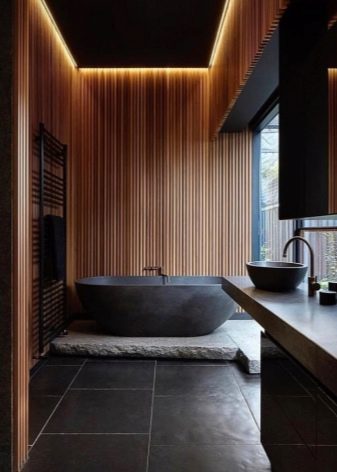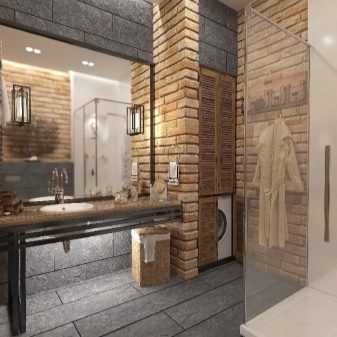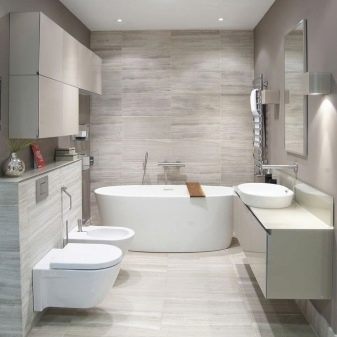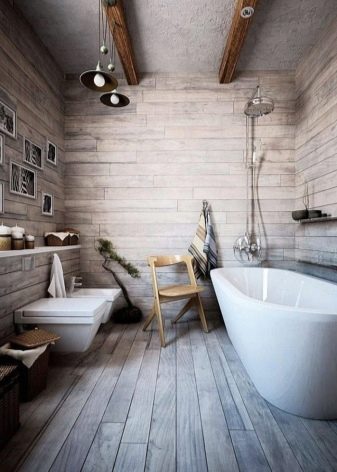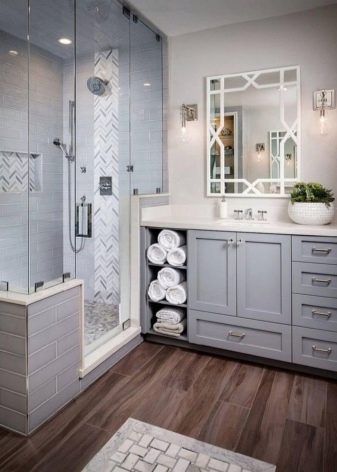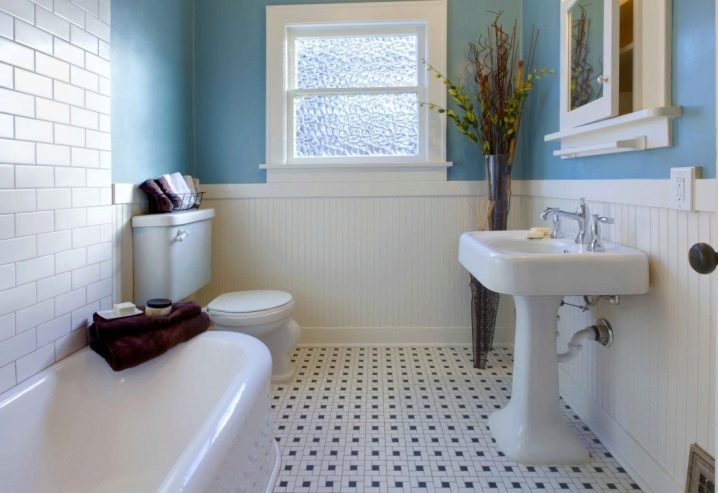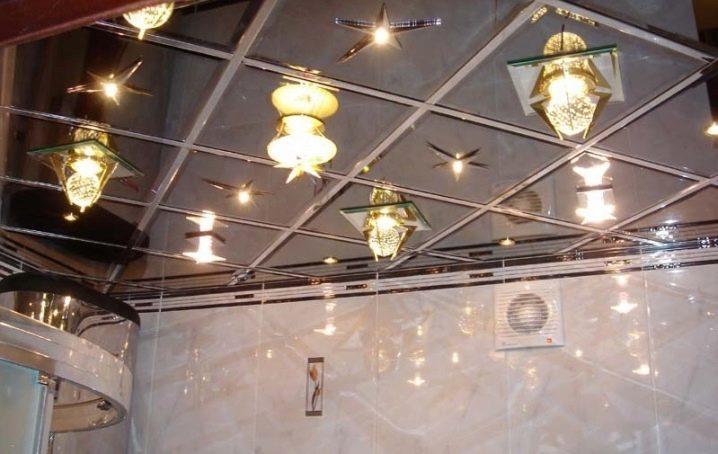Bathroom tiling: fashion ideas and modern design
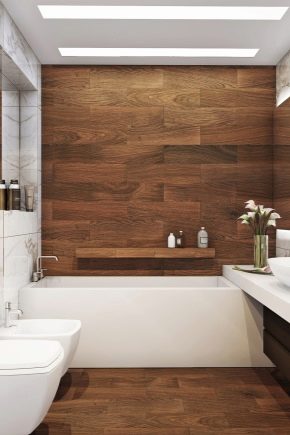
Tiles in the design of the bathroom is the most common facing material. It does not give up its positions along with the appearance of other analogues due to high quality and operational characteristics. It is possible to reveal its design possibilities with a creative approach, a sense of taste and borrowing the foundations of modern design ideas.
Special features
Bathroom is a place of high humidity. Its conditions are associated with constant exposure to water, steam on any object in the room. This is especially true of floors.It is important that the type of finish used does not allow moisture to the enclosing structures and is not subject to destruction. Bathroom tile meets this requirement, even if it is used in an attic bathroom.
This is not only the option of tile, as it seems to the ordinary buyer. Today, under the finishing tile is commonly understood a number of materials for the design of floors. The material may have a different composition. Depending on the type of product, its thickness, density, dimensions, external characteristics and glue selection features change. From this depends on the method of fixing the tiles, which can be traditional adhesive and frame. In each case, requires its own set of inventory, as well as the preparation of the base.
Usually, bathroom tile does not accumulate moisture inside and complies with the basic standards developed for bathroom veneers. If the installation technology is observed, it does not move away from the base, it is held firmly. This finish does not shrink during the drying process and does not deform over its entire life cycle. Depending on the type of material used, it can be natural or synthetic.Finishing a bathroom with a tile is the most rational approach to decorating a bathroom.
Using tiles in the bathroom allows you to radically change the perception of a special space. Due to the proper selection of cladding, you can create different illusions, including increasing the space, raising the ceiling, leveling and expanding the walls. On the modern market, these products are presented in a wide range. The buyer has a choice of finishes, taking into account the taste and wallet.
Requirements
A commonly used type of material for finishing surfaces meets the following requirements.
- Durability. It is used for 10–15 years or more without adjustment.
- Environmental friendliness. The material has harmless components, it does not emit toxic substances during operation.
- Strength. Most varieties are resistant to random mechanical stress.
- Antistatic. Manufacturers process tiles with special compounds. Finishing will not cause the appearance and reproduction of mold fungi.
- Abrasion resistance. In conditions of regular cleaning, surfaces are easily cleaned without harm to the protective layer.
- Resistance to abrasives. With regular cleaning with household chemicals, the material should not be destroyed.
- Fire resistance The tile should not burn in the event of a short circuit.
- Aesthetics. Finishing material should be pleasant externally.
- Availability. The material taken as a basis must be distinguished by an acceptable cost.
Despite a number of requirements, not every tile material meets all parameters. Regardless of the impregnations that increase the moisture resistance of a tile, it is water that causes a reduction in the life of any finish. This is especially noticeable in the case of leaks from the apartments above. In some cases, repair is not possible, you have to completely remove the lining.
Kinds
All existing types of bathroom tiles can be divided into 3 types:
- wall mounted;
- floor standing;
- ceiling.
The differences between the species are obvious. The wall tile is thinner and lighter than the floor counterpart. Ceiling options are larger in size and provide for more than just traditional suture technology. Due to the wavy or curly edges they can be interconnected without visible joints. However, some types of material have lock joints.Floor cladding is often massive. This is due to the need to withstand greater weight load and vibration resistance of the washing machine. Its strength factor is higher, however, it is not suitable for walls: the weight is not designed for bearing.
However, to support the style, trademarks release floor cladding with a wall-mounted companion. Some types of wall tiles are applicable for decoration of accent bathroom ceiling areas.
Advantages and disadvantages
Bathroom tile has a lot of advantages.
- This is a quality material. It is performed on modern equipment with the use of new production technologies and quality control at each stage.
- It decorates the floor and bathroom. With its help, you can give the room an atmosphere of home comfort and relaxation.
- Lining allows you to convey the inner world of the user, relevant in any stylistic design decision.
- This finish has a wide range. The buyer always has a choice between budget and elite options.
- It allows you to disguise unsightly areas of surfaces, to hide irregularities, cracks.
- Bathroom tile is distinguished by a variety of textures.Due to this, you can visually change the area of space.
- It involves the embedding of different lamps and switches. Its structure does not deteriorate with any type of lighting devices.
- Finishing features unlimited decorative possibilities. Due to it, it is possible to zone the bathroom space into separate functional areas.
- Different types of finishes blend harmoniously together. This allows you to make the texture used expressive.
With a large list of advantages, bathroom tile has its drawbacks.
- The material acquires strength at the end of laying. Before that, it is fragile, unstable to mechanical damage, breaks during transportation.
- Any kind of finishing tile needs preliminary preparation of the base. Without it, the lining will not last long.
- The abundance of the same material makes the bathroom interior boring. The texture must be compared with another finish.
- Cutting and drilling holes for lamps or wiring is sometimes accompanied by breakage of the part. To do this you need the right tool.
- Material has to buy with a margin.Butt buying is accompanied by a shortage of parts in the process of cutting and stacking.
Materials
In the manufacture of tiles for use in the bathroom used various raw materials. The most popular types of material for decorating a bathroom with tiles are glass, ceramics, porcelain stoneware, wood, plastic, vinyl, and metal. Less common in the design is rubber. It is the raw material that determines the type of tile.
The tile is more known to the ordinary buyer. These are ceramic dies that are glued to cement-based tile adhesive. Due to it, they become durable and do not let water through to the base. They can be a monolithic surface or a certain accent in the form of a panel. This is a wall and floor finish, which, in addition to concrete and brick floors, is fixed to moisture-resistant drywall. For the floor is more often used porcelain.
Ceiling panels - square-shaped tiles. They are used to decorate the ceiling, sticking directly to the prepared base on a special glue. Details differ in small weight, do not need a frame, can be suture or seamless.Some varieties have a three-dimensional effect and different reflectivity. The form can be square and in the form of geometric shapes.
Cassettes - plastic, metal, mirror and wood tiles (ash, oak, bamboo), fixed on the frame of the profiles in the form of cells. This technology does not provide adhesive bonding. Each tile is inserted into its place and, if necessary, can be replaced by an identical new one. Making convenient ease of dismantling, the ability to insert instead of a separate tile fixtures in the form of panels of identical size.
Ceiling panels for decorating the bathroom are made of metal, wood, plastic and glass. Each type of material has its own characteristics that determine the service life of the coating. The category does not include porous foam tiles - it absorbs moisture, which is associated with the deacidification of the adhesive.
Often in the design of bathroom surfaces use mosaic. It can be made of ceramics, glass and metal and a mirror. Manufacturers produce mosaic products in separate fragments and varieties on the grid. It is easier to glue the second type of material.In this case, it is not necessary to align the joints between small squares and lay out the pattern on the floor before mounting on the prepared surface.
Quartz-vinyl options are a separate topic. This is a facing tile with a base layer of polyvinyl chloride (PVC). The composition includes crushed shell rock and crushed sand. It is elastic, dense, flexible and heavy. The advantages are thermal stability, health safety and imitation of various natural materials.
Sizes of a tile
If the dimensions of other tiles adhere to the figures of 30 x 30, 50 x 50, 60 x 60 cm, the dimensions of ceramic tiles are more diverse. In the past, wall dies were smaller for the floor. Today, trademarks are developing their own standards, so there are often discrepancies up to a few cm between generally accepted norms. For example, along with dimensions for walls 25 x 25, considered to be running size for small rooms, there are options 25 x 33 and 25 x 36 cm.
The options are 10 x 10, 15 x 15, 20 x 20, 20 x 25, 30 x 20 cm. Some manufacturers produce in similar sizes and tile for the floor. This is especially true for companion tiles.With it you can effectively highlight, say, the area of the shower. Sizes of 30 x 60 and 40 x 60 cm are characteristic of floor coverings. Such samples are often used for lining the floor of a bathroom combined with a toilet. They are appropriate on the floor in a separate bathroom.
Arrangement options
Making a bathroom tiles - an occupation that requires a special approach to decorating. It begins with the calculation of finishing on a certain area of the lining, taking into account the practicality and danger of the zone. For example, the most durable, moisture-resistant material is needed to decorate a bath site. Here it is better to use ceramic tiles without pronounced relief. The same rule applies to the shower and facing near the door slopes. Materials here should have a flat (smooth) surface.
Many try to decorate the bath screen tiles to match the walls. It is better for her to choose small dies with a smaller gap in the seams. Fit ceramic tiles without complicated decor. Mosaic is inappropriate here. It is better to choose to emphasize the walls or floor. Such a design will be more interesting, will allow to reveal the beauty of the mosaic tile on the background of larger fragments.
Stylists pay attention to the shape of the tile when it is combined.If fragments of the same size will be in the design a lot, the interior of the bathroom risks becoming limited. In order not to cut it far and wide with visual seams of the tile, it is better to mix it with wall panels or siding for interior decoration. This will simplify the work on the lining and relieve the interior of the bathroom from crushing tile joints.
If you want to use several types of textures, you can tile a zone of a cheap cabin using tiles on the floor, wall and ceiling. For the rest of the space it is desirable to pick up the panel, siding. The wall, as far as possible from the bath, can be decorated with plasterboard. For the floor it is useful to use tiles. At the same time, its size and color should not coincide with the background finish of the shower. If there is a lot of the same texture, it will lose expressiveness.
Design ideas depend on room footage. For example, it is undesirable the abundance of tiles in the limited space of a panel house or small-sized "Khrushchev" with a usable area of no more than 4 square meters. m. However, drywall is inappropriate here. We'll have to choose a light-colored dice for the bath zone, wipe the seams to match them, so as not to create the feeling of a Rubik's cube against the general background. The zone for washing can be beaten by the panel.For the ceiling, it is better to choose plastic tiles, having considered a waterproofing and ventilation system.
Modern layouts often imply spacious rooms for bathrooms. Square meters are more here, so the zoning possibilities are diverse. It is possible to arrange one wall for furniture, for a bath or a shower cabin, to choose another tile, to arrange the ceiling in a combination of drywall with a tile of plastic or wood around the perimeter. There are many options, it all depends on the height of the ceiling, the prospects of a particular room, the presence of niches.
Niches can be distinguished by smooth tiles, the zone of the mirror and sink should be marked with a relief (for example, clinker with a protective layer). The combination of a tile under a brick with equal versions looks beautiful. To balance the severity of the two textures through glass curtains, located in front of the shower. Glass brings ease to any interior that can be used at the expense of mirror types of surfaces.
It is better to visually separate the facing for the walls and the floor. The emphasis should be on one thing. Floor tiles can be laid in the form of carpet. This technique will allow you to beat a more passable zone.For example, using elements of the same color range and border, you can lay out an interesting pattern by combining traditional and diagonal styling.
The same goes for fixing ceiling tiles. It can be made out in different ways. This will relieve the interior of the bathroom from boredom, make the decor special, allow you to beat the disadvantages of the ceiling space, hide communications. Beautifully look tiles with a three-dimensional effect of plastic with mirror inserts. They can be placed in the bathroom as an accent of the washbasin. It is advisable to make the ceiling above the bowl simple.
Colors and decor
The choice of tile color for a bathroom depends on its type, the area of a particular room, its style, taste preferences and the effect of color on the internal perception. The modern approach to the choice of tile hue allows you to reveal the possibilities of each shade of the color palette. Today, stylists propose to move away from the usual stereotypes. The priority is unusual tones, bold combinations of colors, transmitted through the texture and pattern.
Conventionally, the palette can be divided into 4 groups:
- neutral;
- natural;
- pastel;
- bright.
Combining white with gray and black in the spotlight. However, neutral tones are devoid of emotional coloring. To make such an interior seem cozy, you will have to add color accessories in the form of hygienic accessories or decoration of lamps. Popular combination of white with light gray, pearl and gray-beige. This design is more interesting and conveys the special status of home owners.
A favorite of the palette is white. It is mixed with natural tones, which include shades of wood. This technique is appropriate in a different stylistic direction: the combination of white and brown colors is always harmonious. Soft popular contrast is the combination of white and bleached wenge, beige-gray, beige, milk.
Pastels like fans of bright colors. Caramel, mint and coral tones diluted with white, as well as blue are most in demand among buyers. Against the background of lights and mirrors, they look stylish and comfortable. Bright colors of the color palette are trying to use carefully. Not each of them contributes to creating a cozy atmosphere.
For example, a mistake is a combination of black and red, an abundance of wine tiles against a white background. When choosing a black color, you can soften it with white, dilute with brown, purple. Mixing the black and orange tones of a tile is hard to read. The choice of dark material is desirable to balance the light shade of the finishing analogue. The combination of blue and white is better to complement the light gray or steel tone.
Texture
A distinctive feature of bathroom tiles is the variety of texture. These are not just dies with a matte or glossy surface, different reflectivity and a protective layer. In fact, the spectrum of the structure is more extensive. It can be smooth, relief, velvety, rough, nacreous, pearl, three-dimensional. One of the possibilities of the texture is imitation.
Due to the desired shade, overflows, shapes and patterns, you can create the illusion of any material. For example, along with traditional fragments, you can buy tiles for brick, natural stone, granite, marble, malachite, wood. An interesting solution would be an option for a mirror or glass. Some varieties are different thicknesses of the dice at the edges.This complicates the installation and maintenance, but gives the interior originality.
Picture
The use of prints in tile is different from the decoration techniques of the Soviet period. Today it is not customary to repeat the finish in a staggered manner, mixing monochromatic and colorful tiles. This approach to decorating surfaces is somewhat monotonous. Of course, for the floor it can be used, however, for the decoration of the walls it is better to choose a tile-panel. This is a variety that forms a pattern of several fragments.
Details may be identical or different form. This image looks more interesting, especially with the support of a monochromatic background coating. You need to buy such options from one manufacturer of a certain series. So the coincidence tone will be one hundred percent. Decorate the picture can a small part of the bathroom. Even a three-dimensional panel should not fill more than 30% of the total area.
More familiar bathroom decorating techniques are nothing more than a maritime theme. These are drops, dolphins, pictures of the coast, shells, and sometimes palm trees. However, in most cases, the drawing is composite, which forces the tile to be pre-laid on the floor before the lining process.For a floor it is more often the ornaments concluded in geometrical figures. The pattern is usually made in a darker tone, related to the main one.
Styling methods
Carrying out repairs in the bathroom, buy tiles with regard to the method of installation. The form and quantity of raw materials depends on it. It is possible to tile the floor surfaces of the bathroom with your own hands. Today, this is not difficult because of the wide variety of adhesive compositions and instructions with a clear demonstration of the process technique. You can finish the surface using two or even three methods, depending on the conceived idea. However, for the floor laying options more.
Base
Acceptance of the usual laying of square tiles with the formation of crosshairs. Each row is located above the previous one, the same width of the seams is observed. Such a layout can be varied by combining the pattern in the form of a carpet. Use this method of lining for laying floor, wall and ceiling tiles.
Diagonal
This technique is suitable for laying cladding on walls, ceiling and floor. One of the false methods using square-shaped fragments. It differs from the previous method by rotating the tile by 45 degrees.Carried out with the formation of crosshairs. Complicated by the need to trim dice in the corners of adjacent walls. It looks interesting, combined with the traditional method of laying.
In the run
In essence, the styling technology resembles the basic one, however, with a slight difference. Fragments are not connected to crosshairs. This is an offset method. In fact, this is a derivative of brickwork, when fragments are glued with a shift by half the length of the tile. Usually for such masonry use details of a rectangular shape of a small size. Such styling looks stylish, especially with a matte surface and texture under a brick or board. It can be classic and diagonal.
Herringbone
This method is suitable for surface finishing with rectangular tiles. The method is based on the flooring. The tiles are laid at an angle of 45 degrees, forming a zigzag line. The technique has two derivatives: the traditional method and the version with the attachment. In the second case, a mosaic tile is inserted into the middle of each tile. If you do not want to use the mosaic, to the main decoration buy a tile of a smaller size identical in thickness and texture. Color may vary.
Modular
One of the complex techniques of facing bathroom surfaces. Designed primarily for finishing the floor. This is an assembly of a coating of tile modules of various sizes and shapes, but of equal thickness. Figure may be different. Its degree of difficulty depends on the variety of material purchased. Sometimes up to 5 samples of different sizes can participate in the decoration. The basic rule of laying - compliance with the figure. The difficulty is the calculation of the required amount with regard to trimming.
Parquet with shift
Advanced modular styling technology. It can be a combination of square and rectangular elements, a combination of squares of different sizes with an offset by half the length of the face or in an arbitrary order. The offset can be quite small if the mosaic is used. The technology does not provide crosshairs. They try to make the distance between the tiles identical due to the use of special clips.
Figured
For this technology, tiles with an uneven edge are used. The technology for the ceiling material does not provide for the presence of joints. When carry out laying on the floor, there are seams.The disadvantage of the method is the necessity of preliminary calibration of the fragments used and one-sided type of laying. The advantage is the unusualness of the decoration: the floor in the form of such puzzles looks spectacular.
In different styles
With the help of the tile it is possible to show the belonging of the bathroom interior to a certain stylistic decision. To make the effect more pronounced, they try to use tiles as an emphasis on one of the zones. For example, for vintage areas of design, it is important to show a light tone and matte texture. In this case, the tile can be made in the shade of light oak wenge under the texture of painted wood. Arrange it better as a panel or floor.
If you want to show the modern direction, you can take as a basis the glossy type of material surface. The emphasis is on functionality and the absence of unnecessary decorations. This role can be left to the lamp, mirror, furniture or the bath itself. An excellent solution would be facing a section of the shower cabin to glass curtains. The best choice is considered a tile of natural shades or divorces of brown and gray.
When the soul to the creative, you can combine brickwork with panels. You do not need to lay out any patterns. Enough unusual textures, their deliberate rudeness. The use of shades and textures for plaster, concrete, lime. In combination with lamps, fans or lanterns tile will play in a special way.
Classical techniques can not be without gloss and luxury. It is important to show the high cost. You can apply the decoration of the dies with a gold-plated pattern, use a combination of matte and glossy texture, decorate the walls with a mass of gold-framed fixtures after finishing the wall. The tones in this case are predominantly light, with a priority of white, milky, ivory. You can choose a pattern for the tile, repeating the finish mirror frame or carved furniture (cabinet, table, legs, shelves).
Separate branch are ethnic trends with their inherent identity. As a rule, such a tile is bright, conveys the elements of culture of one of the countries. This could be a branch of Sakura with petals soaring in the wind or a Greek vase ornament, the color of the animal's skin, which is important for African subjects. Options for the use of tiles mass.She can designate the area of the washing machine, resting place, highlight the bath screen. Mosaic can be used to decorate columns, screens, mirrors.
Manufacturers
The market for tile coatings for the bathroom is replete with a variety of products. This often puzzles the buyer, because each brand advertises exclusively its product. To help an ordinary customer choose a quality lining, you can pay attention to the products of several manufacturers, known in its segment.
- Cersanit S. A. - Polish company, manufacturer of ceramic tiles. The range includes 40 collections with a variety of patterns. Dies have a rich choice of colors, do not fade and are resistant to abrasion.
- Kerama marazzi - Russian-Italian company, a manufacturer of ceramics with high quality and performance characteristics. Original design, durability, application of innovative technologies are the main techniques of the company.
- Golden tile - Ukrainian brand that deserves attention. The tile of the company has no deviations in shades, it differs in original design and budgetary cost. Attracts the attention of the buyer a wide range.
- Far ceramiche - tile with high Italian quality. The design of the dice is striking variety and unusual. The composition of the material does not contain harmful impurities. The tile does not change external characteristics for many years, does not erase and does not fade.
- Qatar - tile and porcelain tiles from Lasselsberger. Wall and floor coverings, high-quality and stylish lining for bathrooms, characterized by moderate cost.
Product reviews of these brands are sometimes associated with negative reviews. For example, customers point out the imperfect combination of floor tiles and walls at Kerama Marazzi. With regards to the company Cersanit noted that the dies are not always different impeccable geometry. At the tiles of the company Golden Tile buyers have identified variations in size. Far Ceramiche is marked by customer reviews, as expensive, inaccessible to everyone tile.
Beautiful examples
Modern use of tiles in the bathroom is akin to art. Finishing material is successful when used in an apartment and a private house. Evaluate the possibility of using tiles in the bathroom will help examples of the photo gallery.
An example of accentuating the wash area modular tiles. A good choice of texture and color, coinciding with the general concept of style.
The original choice of flooring for Provence style.The texture, pattern and color fit perfectly into the design of the bathroom, combined with the toilet.
Unusual solution design bathroom in oriental style. Combination of different textures, the use of dark tones.
Selection of a niche tile with a three-dimensional ornamental pattern. Stylish course of decorating the wash zone, a good combination of colors.
Isolation of the wet zone around the bath fits into the Japanese style. Using the texture of wood.
Loft style bathroom attracts a combination of coarse textures. Spectacular interpretation of an industrial facility. The combination of tiles for concrete and brick.
Neutral version of high-tech style. Using tiles does not create a fragmentation effect. Selection of the bath zone.
Chalet style bathroom. The abundance of tiles is smoothed by the ceiling design.
The design of the shower with tiles with accents. The combination of two textures and playing around a niche.
Acceptance of the use of tiles for bath and floor. Facing looks impressive against the background of wall slats in the form of panels.
Bright solution with patchwork interpretation. Using mosaics to accent niches and walls near the toilet and sink.
Another solution in the spirit of loft. Matt type texture tiles in combination with a concrete surface.The atmosphere of an industrial facility transferred to the full.
Bathroom ceiling decoration with relief tiles with a metallic sheen. Ceiling tiles in combination with floor and wall. Bathroom zoning.
How to lay tile in the bathroom, you will learn from the following video.
